BEO1105 Assignment: Applying Economic Principles to Market Analysis
VerifiedAdded on 2023/06/12
|11
|1534
|145
Homework Assignment
AI Summary
This assignment delves into fundamental economic principles, analyzing demand, supply, and market equilibrium through various scenarios. It examines the relationship between price and demand, considering factors beyond the typical downward-sloping demand curve. The impact of external events, such as poor harvests, on market dynamics is explored, specifically focusing on the French and Australian wine markets. Furthermore, the assignment investigates the effects of changes in substitute goods' prices and input costs on market equilibrium, using the example of orange juice. The concept of price elasticity of demand is applied to the taxi industry, analyzing its influence on revenue. Finally, the assignment assesses a firm's profitability and optimal output level, advising on short-run and long-run operational decisions. Desklib provides a platform for students to access similar solved assignments and past papers for comprehensive learning.
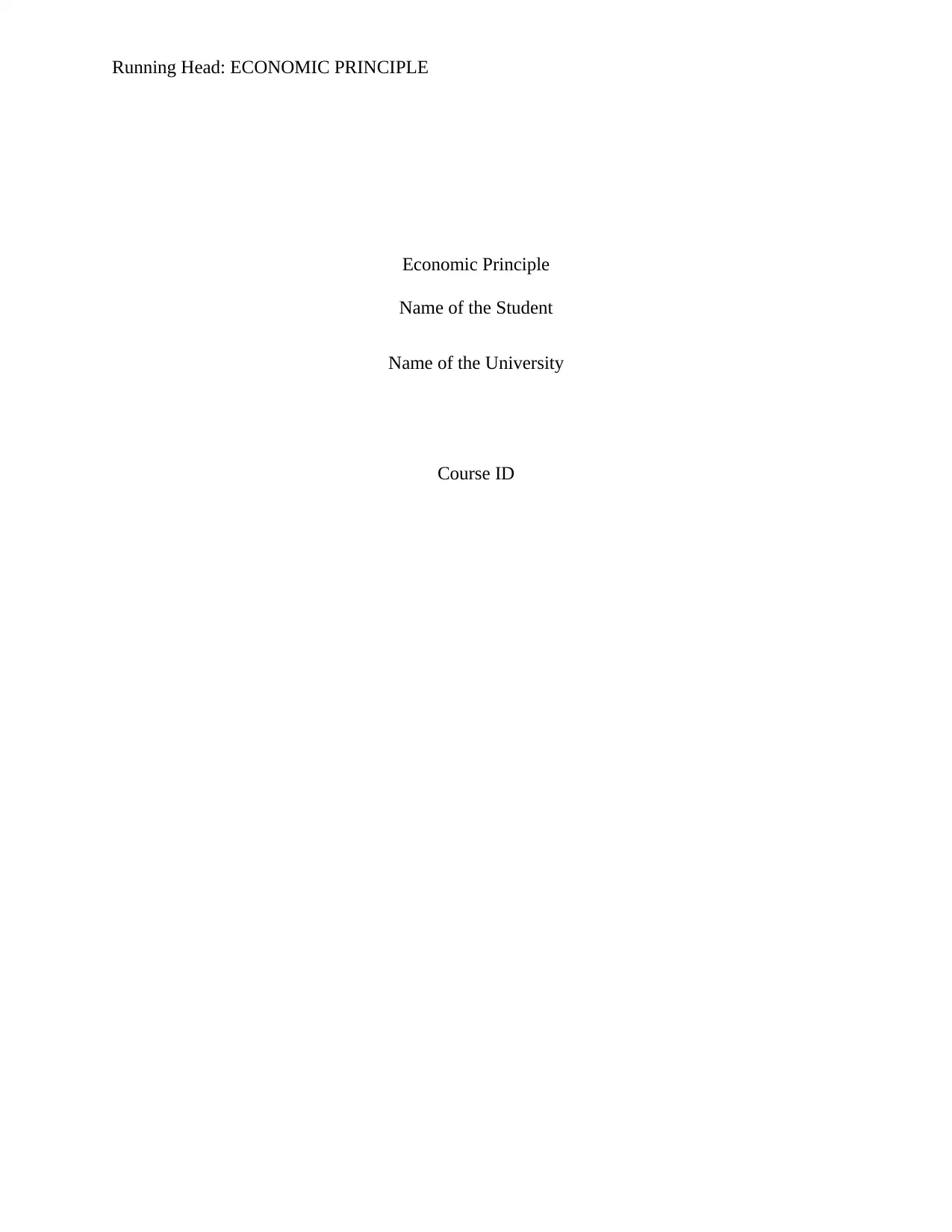
Running Head: ECONOMIC PRINCIPLE
Economic Principle
Name of the Student
Name of the University
Course ID
Economic Principle
Name of the Student
Name of the University
Course ID
Paraphrase This Document
Need a fresh take? Get an instant paraphrase of this document with our AI Paraphraser
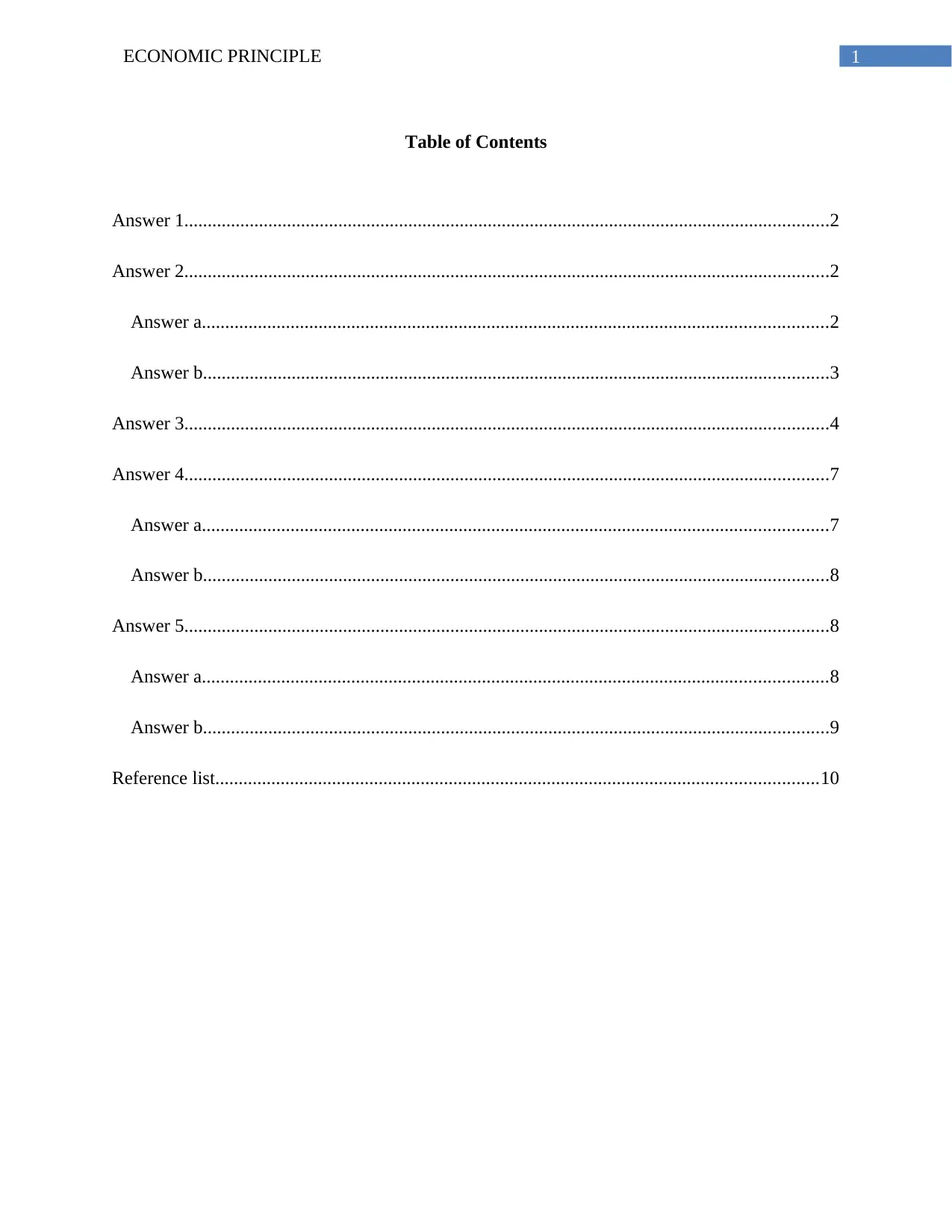
1ECONOMIC PRINCIPLE
Table of Contents
Answer 1..........................................................................................................................................2
Answer 2..........................................................................................................................................2
Answer a......................................................................................................................................2
Answer b......................................................................................................................................3
Answer 3..........................................................................................................................................4
Answer 4..........................................................................................................................................7
Answer a......................................................................................................................................7
Answer b......................................................................................................................................8
Answer 5..........................................................................................................................................8
Answer a......................................................................................................................................8
Answer b......................................................................................................................................9
Reference list.................................................................................................................................10
Table of Contents
Answer 1..........................................................................................................................................2
Answer 2..........................................................................................................................................2
Answer a......................................................................................................................................2
Answer b......................................................................................................................................3
Answer 3..........................................................................................................................................4
Answer 4..........................................................................................................................................7
Answer a......................................................................................................................................7
Answer b......................................................................................................................................8
Answer 5..........................................................................................................................................8
Answer a......................................................................................................................................8
Answer b......................................................................................................................................9
Reference list.................................................................................................................................10
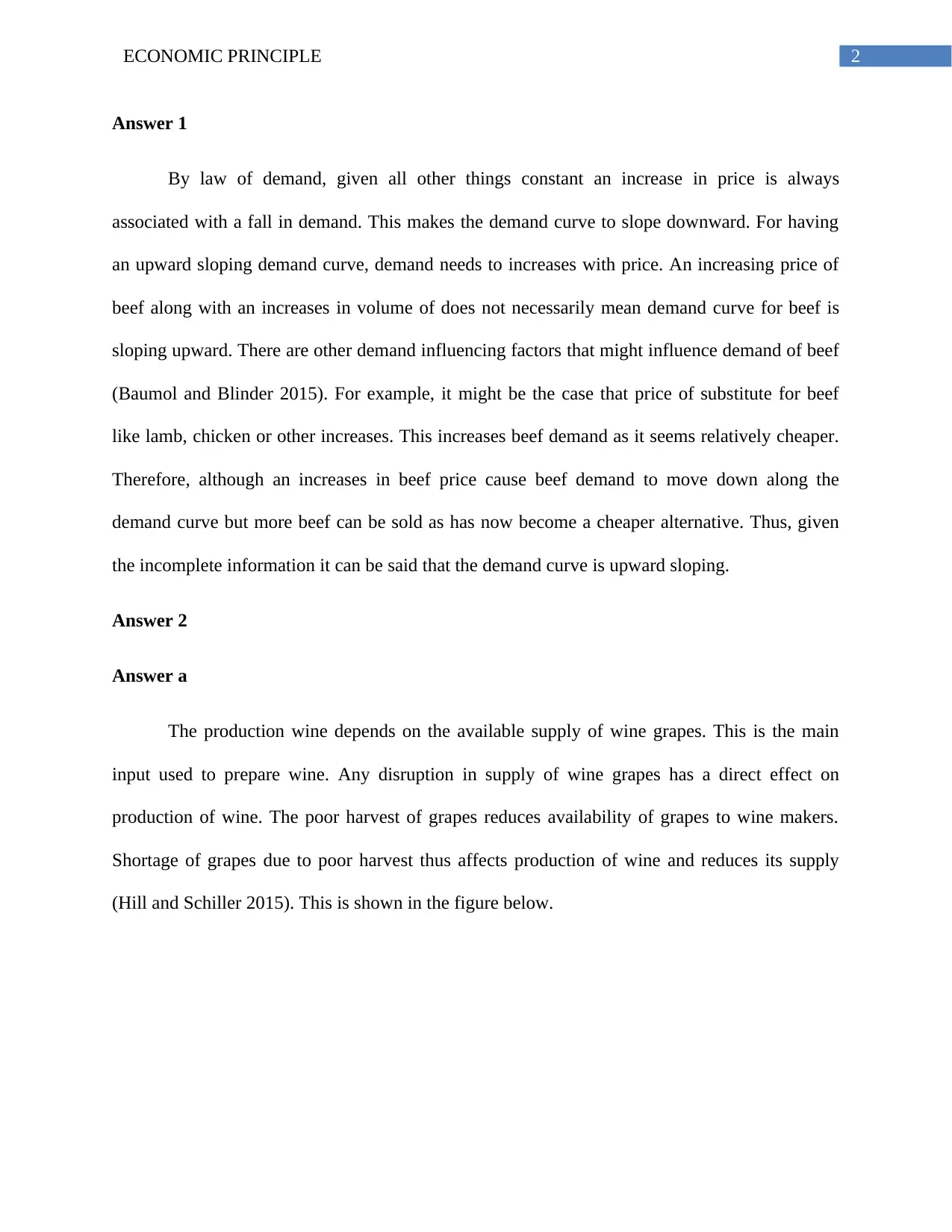
2ECONOMIC PRINCIPLE
Answer 1
By law of demand, given all other things constant an increase in price is always
associated with a fall in demand. This makes the demand curve to slope downward. For having
an upward sloping demand curve, demand needs to increases with price. An increasing price of
beef along with an increases in volume of does not necessarily mean demand curve for beef is
sloping upward. There are other demand influencing factors that might influence demand of beef
(Baumol and Blinder 2015). For example, it might be the case that price of substitute for beef
like lamb, chicken or other increases. This increases beef demand as it seems relatively cheaper.
Therefore, although an increases in beef price cause beef demand to move down along the
demand curve but more beef can be sold as has now become a cheaper alternative. Thus, given
the incomplete information it can be said that the demand curve is upward sloping.
Answer 2
Answer a
The production wine depends on the available supply of wine grapes. This is the main
input used to prepare wine. Any disruption in supply of wine grapes has a direct effect on
production of wine. The poor harvest of grapes reduces availability of grapes to wine makers.
Shortage of grapes due to poor harvest thus affects production of wine and reduces its supply
(Hill and Schiller 2015). This is shown in the figure below.
Answer 1
By law of demand, given all other things constant an increase in price is always
associated with a fall in demand. This makes the demand curve to slope downward. For having
an upward sloping demand curve, demand needs to increases with price. An increasing price of
beef along with an increases in volume of does not necessarily mean demand curve for beef is
sloping upward. There are other demand influencing factors that might influence demand of beef
(Baumol and Blinder 2015). For example, it might be the case that price of substitute for beef
like lamb, chicken or other increases. This increases beef demand as it seems relatively cheaper.
Therefore, although an increases in beef price cause beef demand to move down along the
demand curve but more beef can be sold as has now become a cheaper alternative. Thus, given
the incomplete information it can be said that the demand curve is upward sloping.
Answer 2
Answer a
The production wine depends on the available supply of wine grapes. This is the main
input used to prepare wine. Any disruption in supply of wine grapes has a direct effect on
production of wine. The poor harvest of grapes reduces availability of grapes to wine makers.
Shortage of grapes due to poor harvest thus affects production of wine and reduces its supply
(Hill and Schiller 2015). This is shown in the figure below.
⊘ This is a preview!⊘
Do you want full access?
Subscribe today to unlock all pages.

Trusted by 1+ million students worldwide
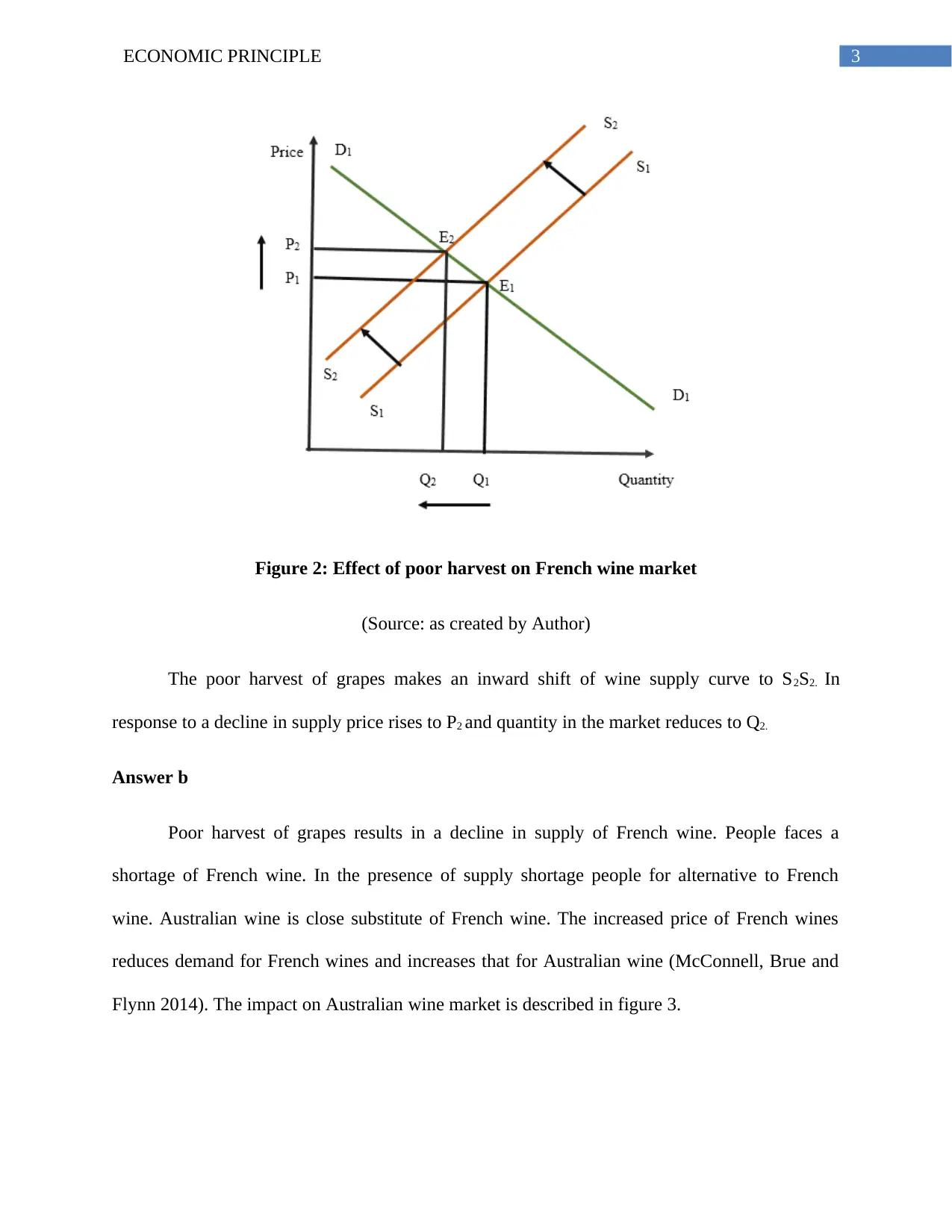
3ECONOMIC PRINCIPLE
Figure 2: Effect of poor harvest on French wine market
(Source: as created by Author)
The poor harvest of grapes makes an inward shift of wine supply curve to S2S2. In
response to a decline in supply price rises to P2 and quantity in the market reduces to Q2.
Answer b
Poor harvest of grapes results in a decline in supply of French wine. People faces a
shortage of French wine. In the presence of supply shortage people for alternative to French
wine. Australian wine is close substitute of French wine. The increased price of French wines
reduces demand for French wines and increases that for Australian wine (McConnell, Brue and
Flynn 2014). The impact on Australian wine market is described in figure 3.
Figure 2: Effect of poor harvest on French wine market
(Source: as created by Author)
The poor harvest of grapes makes an inward shift of wine supply curve to S2S2. In
response to a decline in supply price rises to P2 and quantity in the market reduces to Q2.
Answer b
Poor harvest of grapes results in a decline in supply of French wine. People faces a
shortage of French wine. In the presence of supply shortage people for alternative to French
wine. Australian wine is close substitute of French wine. The increased price of French wines
reduces demand for French wines and increases that for Australian wine (McConnell, Brue and
Flynn 2014). The impact on Australian wine market is described in figure 3.
Paraphrase This Document
Need a fresh take? Get an instant paraphrase of this document with our AI Paraphraser
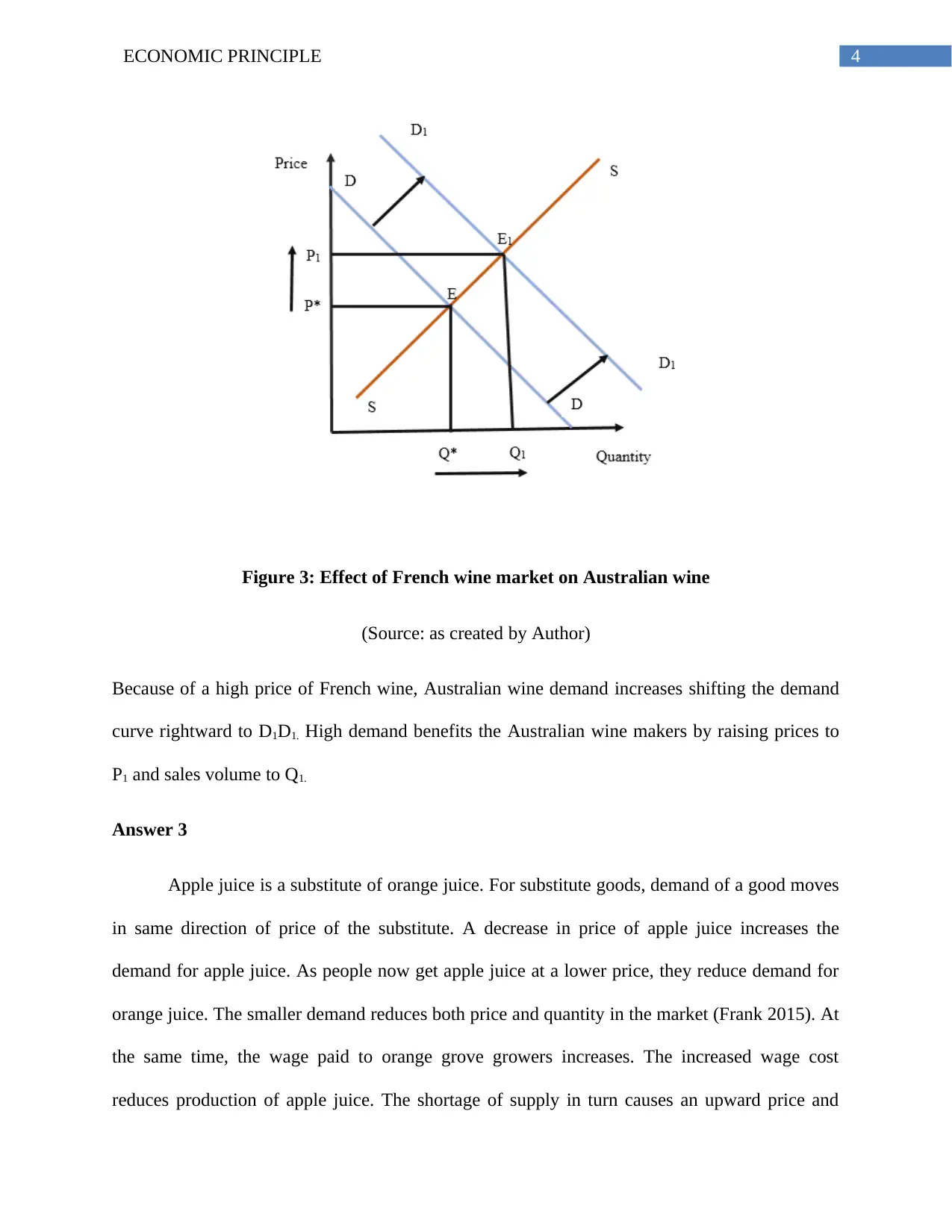
4ECONOMIC PRINCIPLE
Figure 3: Effect of French wine market on Australian wine
(Source: as created by Author)
Because of a high price of French wine, Australian wine demand increases shifting the demand
curve rightward to D1D1. High demand benefits the Australian wine makers by raising prices to
P1 and sales volume to Q1.
Answer 3
Apple juice is a substitute of orange juice. For substitute goods, demand of a good moves
in same direction of price of the substitute. A decrease in price of apple juice increases the
demand for apple juice. As people now get apple juice at a lower price, they reduce demand for
orange juice. The smaller demand reduces both price and quantity in the market (Frank 2015). At
the same time, the wage paid to orange grove growers increases. The increased wage cost
reduces production of apple juice. The shortage of supply in turn causes an upward price and
Figure 3: Effect of French wine market on Australian wine
(Source: as created by Author)
Because of a high price of French wine, Australian wine demand increases shifting the demand
curve rightward to D1D1. High demand benefits the Australian wine makers by raising prices to
P1 and sales volume to Q1.
Answer 3
Apple juice is a substitute of orange juice. For substitute goods, demand of a good moves
in same direction of price of the substitute. A decrease in price of apple juice increases the
demand for apple juice. As people now get apple juice at a lower price, they reduce demand for
orange juice. The smaller demand reduces both price and quantity in the market (Frank 2015). At
the same time, the wage paid to orange grove growers increases. The increased wage cost
reduces production of apple juice. The shortage of supply in turn causes an upward price and
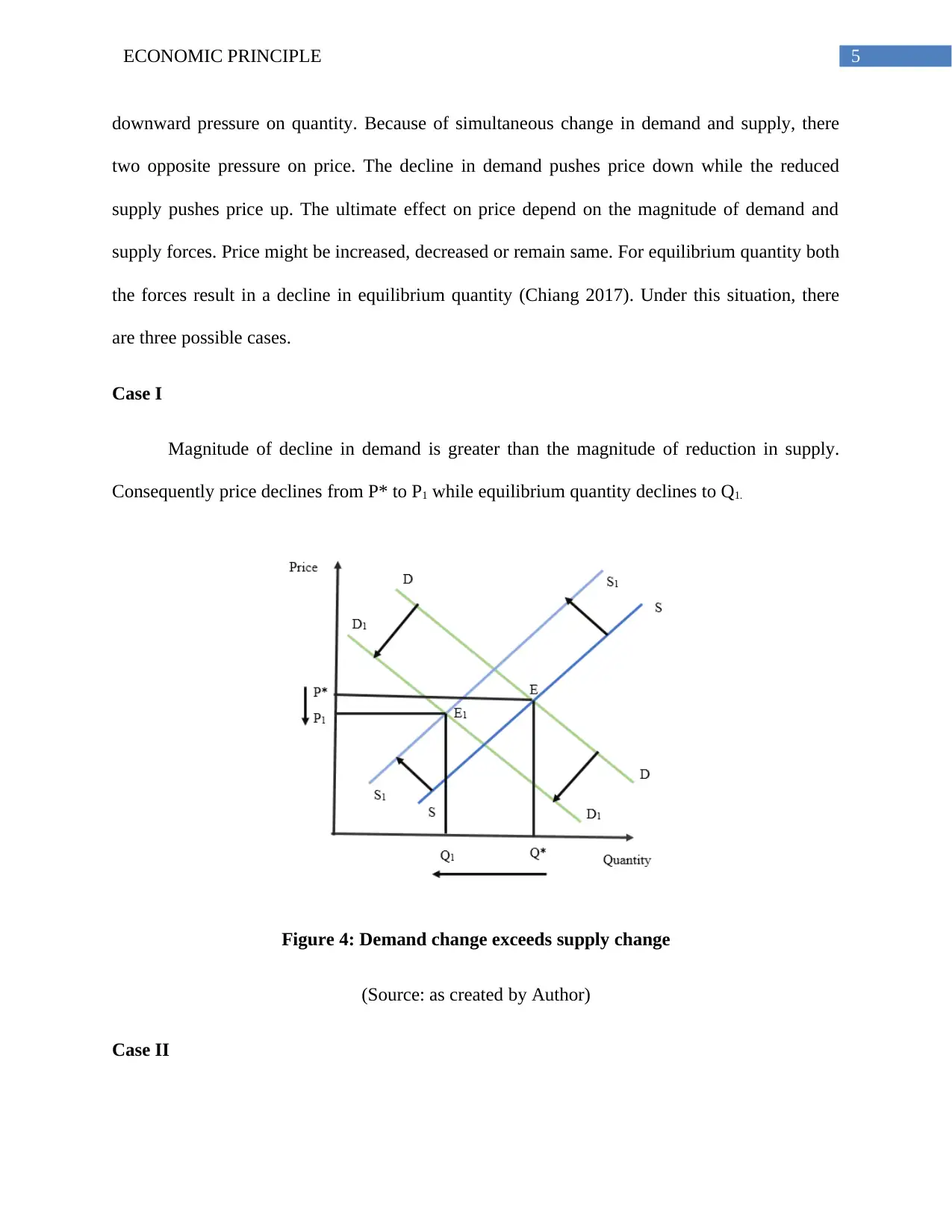
5ECONOMIC PRINCIPLE
downward pressure on quantity. Because of simultaneous change in demand and supply, there
two opposite pressure on price. The decline in demand pushes price down while the reduced
supply pushes price up. The ultimate effect on price depend on the magnitude of demand and
supply forces. Price might be increased, decreased or remain same. For equilibrium quantity both
the forces result in a decline in equilibrium quantity (Chiang 2017). Under this situation, there
are three possible cases.
Case I
Magnitude of decline in demand is greater than the magnitude of reduction in supply.
Consequently price declines from P* to P1 while equilibrium quantity declines to Q1.
Figure 4: Demand change exceeds supply change
(Source: as created by Author)
Case II
downward pressure on quantity. Because of simultaneous change in demand and supply, there
two opposite pressure on price. The decline in demand pushes price down while the reduced
supply pushes price up. The ultimate effect on price depend on the magnitude of demand and
supply forces. Price might be increased, decreased or remain same. For equilibrium quantity both
the forces result in a decline in equilibrium quantity (Chiang 2017). Under this situation, there
are three possible cases.
Case I
Magnitude of decline in demand is greater than the magnitude of reduction in supply.
Consequently price declines from P* to P1 while equilibrium quantity declines to Q1.
Figure 4: Demand change exceeds supply change
(Source: as created by Author)
Case II
⊘ This is a preview!⊘
Do you want full access?
Subscribe today to unlock all pages.

Trusted by 1+ million students worldwide
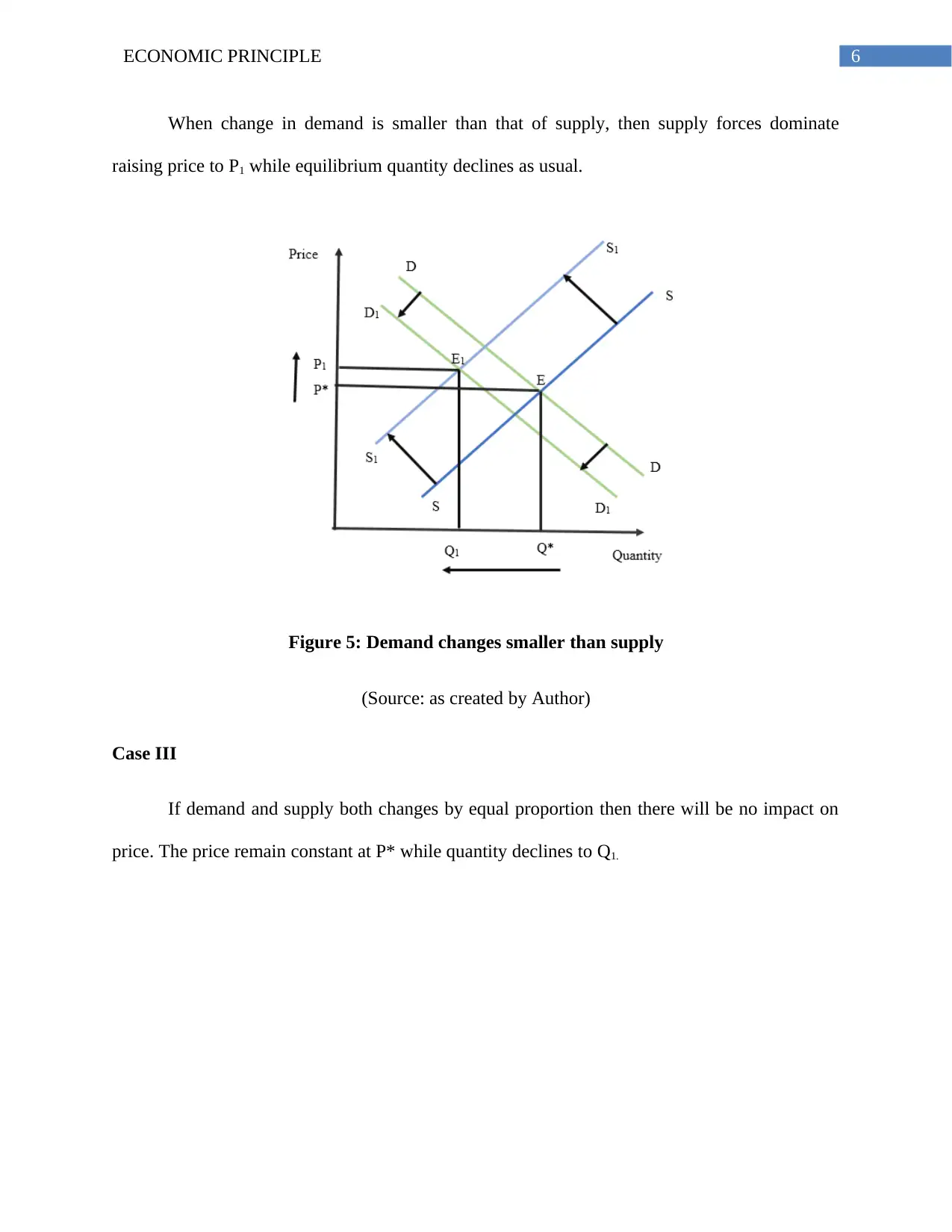
6ECONOMIC PRINCIPLE
When change in demand is smaller than that of supply, then supply forces dominate
raising price to P1 while equilibrium quantity declines as usual.
Figure 5: Demand changes smaller than supply
(Source: as created by Author)
Case III
If demand and supply both changes by equal proportion then there will be no impact on
price. The price remain constant at P* while quantity declines to Q1.
When change in demand is smaller than that of supply, then supply forces dominate
raising price to P1 while equilibrium quantity declines as usual.
Figure 5: Demand changes smaller than supply
(Source: as created by Author)
Case III
If demand and supply both changes by equal proportion then there will be no impact on
price. The price remain constant at P* while quantity declines to Q1.
Paraphrase This Document
Need a fresh take? Get an instant paraphrase of this document with our AI Paraphraser
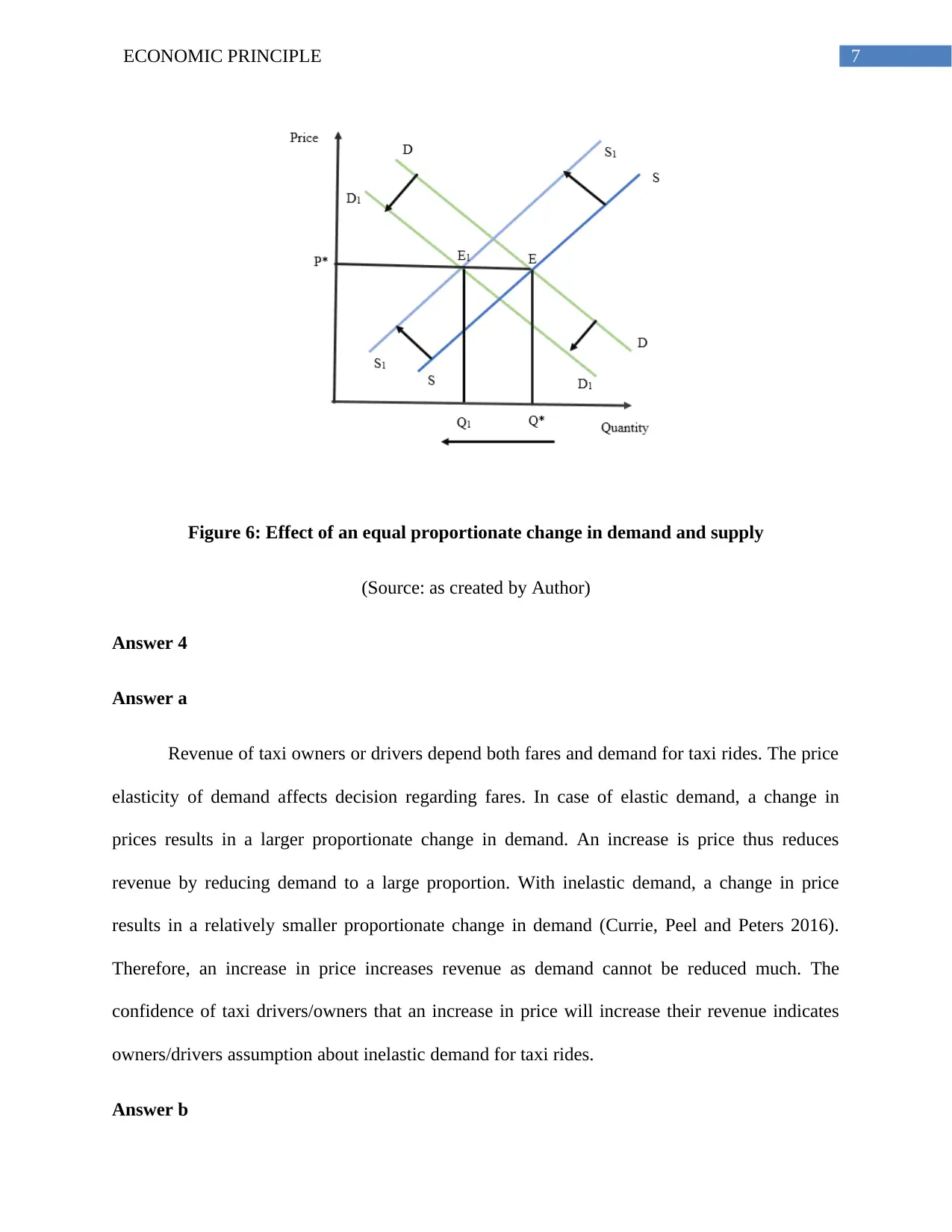
7ECONOMIC PRINCIPLE
Figure 6: Effect of an equal proportionate change in demand and supply
(Source: as created by Author)
Answer 4
Answer a
Revenue of taxi owners or drivers depend both fares and demand for taxi rides. The price
elasticity of demand affects decision regarding fares. In case of elastic demand, a change in
prices results in a larger proportionate change in demand. An increase is price thus reduces
revenue by reducing demand to a large proportion. With inelastic demand, a change in price
results in a relatively smaller proportionate change in demand (Currie, Peel and Peters 2016).
Therefore, an increase in price increases revenue as demand cannot be reduced much. The
confidence of taxi drivers/owners that an increase in price will increase their revenue indicates
owners/drivers assumption about inelastic demand for taxi rides.
Answer b
Figure 6: Effect of an equal proportionate change in demand and supply
(Source: as created by Author)
Answer 4
Answer a
Revenue of taxi owners or drivers depend both fares and demand for taxi rides. The price
elasticity of demand affects decision regarding fares. In case of elastic demand, a change in
prices results in a larger proportionate change in demand. An increase is price thus reduces
revenue by reducing demand to a large proportion. With inelastic demand, a change in price
results in a relatively smaller proportionate change in demand (Currie, Peel and Peters 2016).
Therefore, an increase in price increases revenue as demand cannot be reduced much. The
confidence of taxi drivers/owners that an increase in price will increase their revenue indicates
owners/drivers assumption about inelastic demand for taxi rides.
Answer b
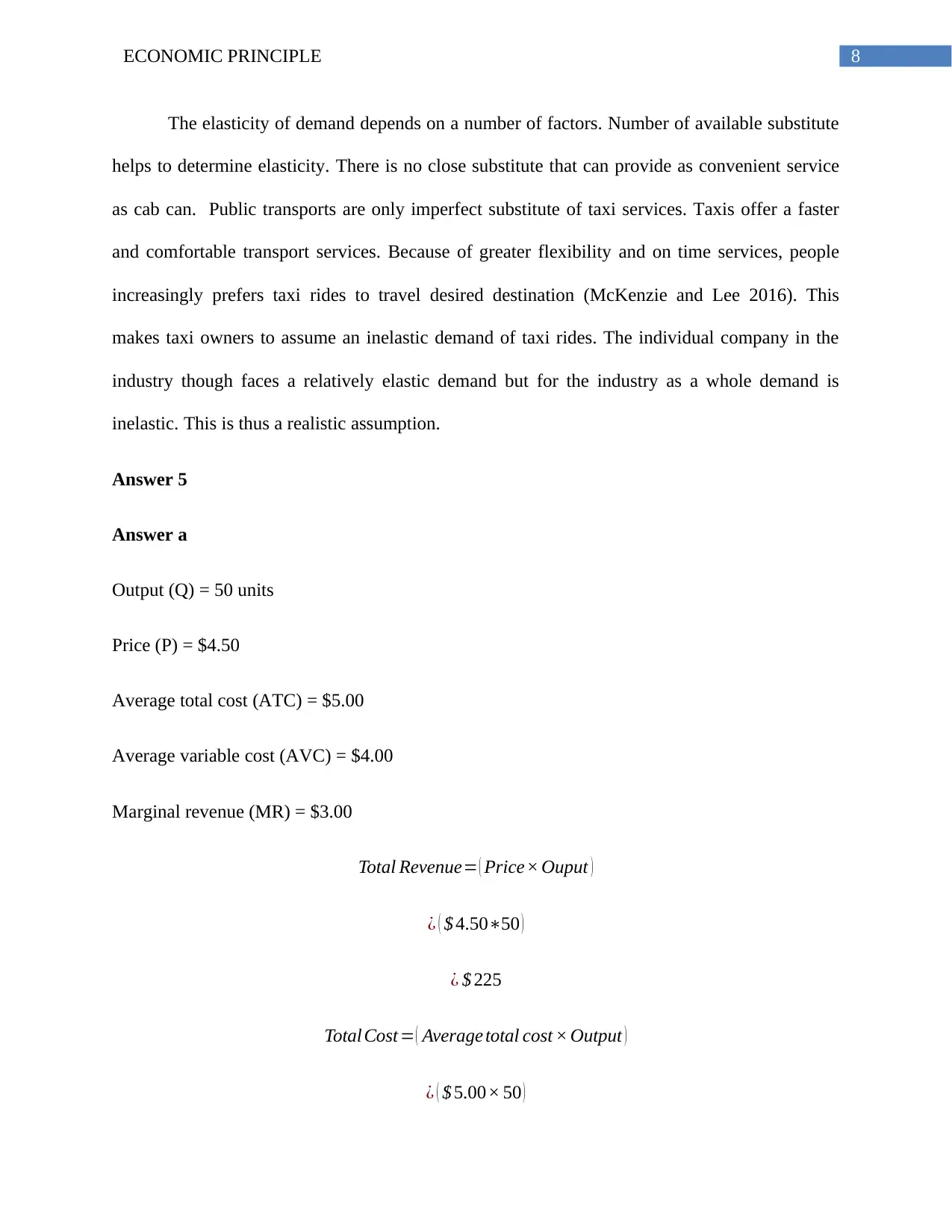
8ECONOMIC PRINCIPLE
The elasticity of demand depends on a number of factors. Number of available substitute
helps to determine elasticity. There is no close substitute that can provide as convenient service
as cab can. Public transports are only imperfect substitute of taxi services. Taxis offer a faster
and comfortable transport services. Because of greater flexibility and on time services, people
increasingly prefers taxi rides to travel desired destination (McKenzie and Lee 2016). This
makes taxi owners to assume an inelastic demand of taxi rides. The individual company in the
industry though faces a relatively elastic demand but for the industry as a whole demand is
inelastic. This is thus a realistic assumption.
Answer 5
Answer a
Output (Q) = 50 units
Price (P) = $4.50
Average total cost (ATC) = $5.00
Average variable cost (AVC) = $4.00
Marginal revenue (MR) = $3.00
Total Revenue= ( Price× Ouput )
¿ ( $ 4.50∗50 )
¿ $ 225
Total Cost = ( Average total cost × Output )
¿ ( $ 5.00× 50 )
The elasticity of demand depends on a number of factors. Number of available substitute
helps to determine elasticity. There is no close substitute that can provide as convenient service
as cab can. Public transports are only imperfect substitute of taxi services. Taxis offer a faster
and comfortable transport services. Because of greater flexibility and on time services, people
increasingly prefers taxi rides to travel desired destination (McKenzie and Lee 2016). This
makes taxi owners to assume an inelastic demand of taxi rides. The individual company in the
industry though faces a relatively elastic demand but for the industry as a whole demand is
inelastic. This is thus a realistic assumption.
Answer 5
Answer a
Output (Q) = 50 units
Price (P) = $4.50
Average total cost (ATC) = $5.00
Average variable cost (AVC) = $4.00
Marginal revenue (MR) = $3.00
Total Revenue= ( Price× Ouput )
¿ ( $ 4.50∗50 )
¿ $ 225
Total Cost = ( Average total cost × Output )
¿ ( $ 5.00× 50 )
⊘ This is a preview!⊘
Do you want full access?
Subscribe today to unlock all pages.

Trusted by 1+ million students worldwide
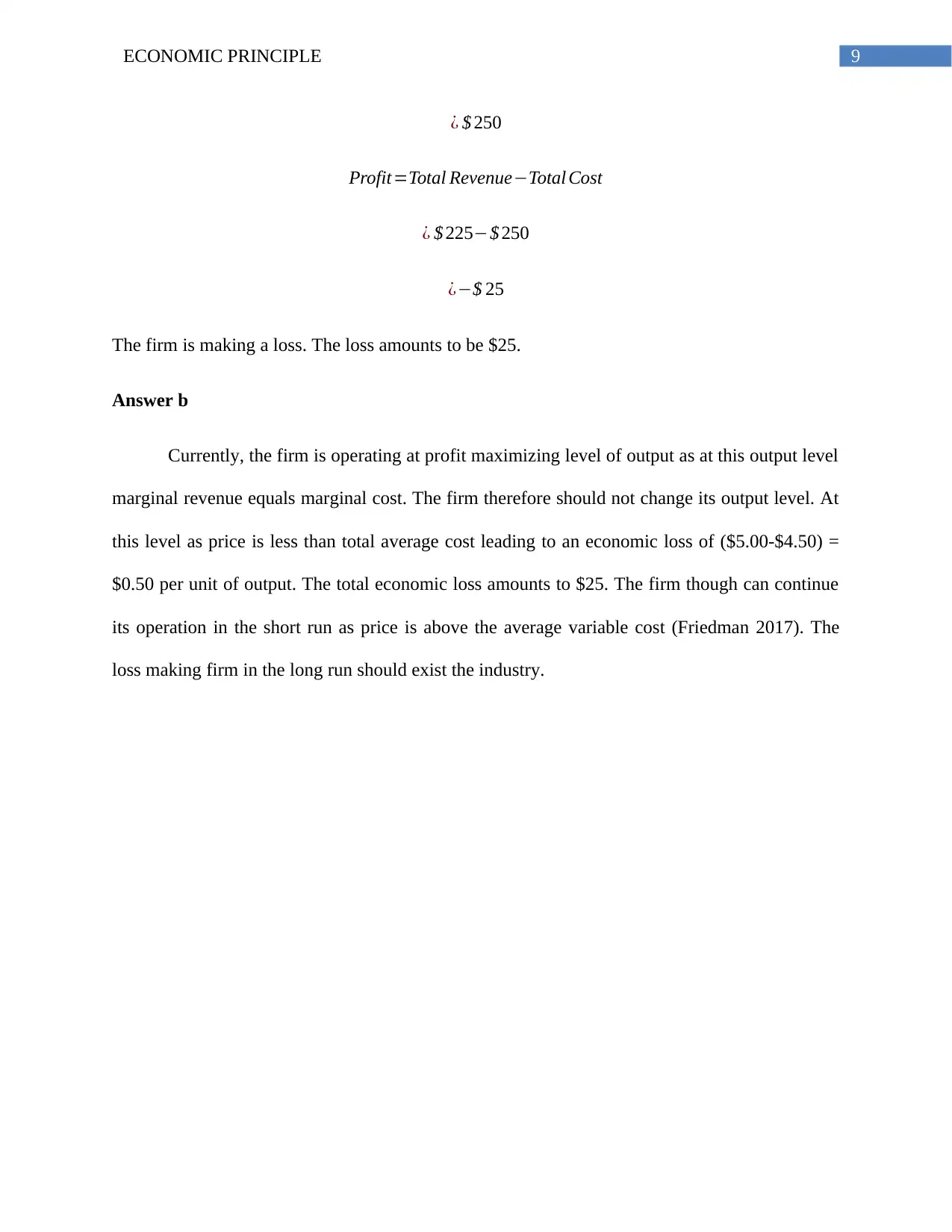
9ECONOMIC PRINCIPLE
¿ $ 250
Profit=Total Revenue−Total Cost
¿ $ 225−$ 250
¿−$ 25
The firm is making a loss. The loss amounts to be $25.
Answer b
Currently, the firm is operating at profit maximizing level of output as at this output level
marginal revenue equals marginal cost. The firm therefore should not change its output level. At
this level as price is less than total average cost leading to an economic loss of ($5.00-$4.50) =
$0.50 per unit of output. The total economic loss amounts to $25. The firm though can continue
its operation in the short run as price is above the average variable cost (Friedman 2017). The
loss making firm in the long run should exist the industry.
¿ $ 250
Profit=Total Revenue−Total Cost
¿ $ 225−$ 250
¿−$ 25
The firm is making a loss. The loss amounts to be $25.
Answer b
Currently, the firm is operating at profit maximizing level of output as at this output level
marginal revenue equals marginal cost. The firm therefore should not change its output level. At
this level as price is less than total average cost leading to an economic loss of ($5.00-$4.50) =
$0.50 per unit of output. The total economic loss amounts to $25. The firm though can continue
its operation in the short run as price is above the average variable cost (Friedman 2017). The
loss making firm in the long run should exist the industry.
Paraphrase This Document
Need a fresh take? Get an instant paraphrase of this document with our AI Paraphraser
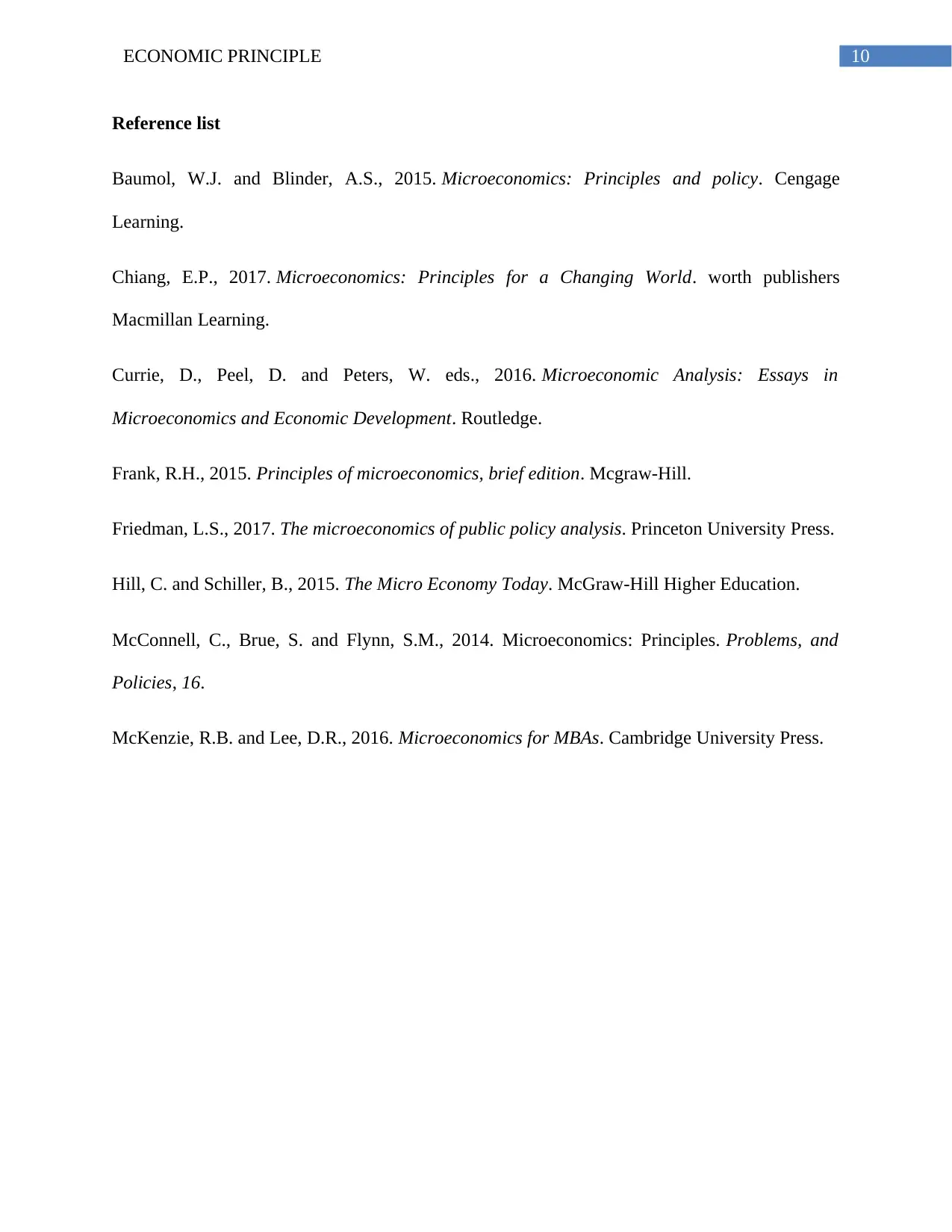
10ECONOMIC PRINCIPLE
Reference list
Baumol, W.J. and Blinder, A.S., 2015. Microeconomics: Principles and policy. Cengage
Learning.
Chiang, E.P., 2017. Microeconomics: Principles for a Changing World. worth publishers
Macmillan Learning.
Currie, D., Peel, D. and Peters, W. eds., 2016. Microeconomic Analysis: Essays in
Microeconomics and Economic Development. Routledge.
Frank, R.H., 2015. Principles of microeconomics, brief edition. Mcgraw-Hill.
Friedman, L.S., 2017. The microeconomics of public policy analysis. Princeton University Press.
Hill, C. and Schiller, B., 2015. The Micro Economy Today. McGraw-Hill Higher Education.
McConnell, C., Brue, S. and Flynn, S.M., 2014. Microeconomics: Principles. Problems, and
Policies, 16.
McKenzie, R.B. and Lee, D.R., 2016. Microeconomics for MBAs. Cambridge University Press.
Reference list
Baumol, W.J. and Blinder, A.S., 2015. Microeconomics: Principles and policy. Cengage
Learning.
Chiang, E.P., 2017. Microeconomics: Principles for a Changing World. worth publishers
Macmillan Learning.
Currie, D., Peel, D. and Peters, W. eds., 2016. Microeconomic Analysis: Essays in
Microeconomics and Economic Development. Routledge.
Frank, R.H., 2015. Principles of microeconomics, brief edition. Mcgraw-Hill.
Friedman, L.S., 2017. The microeconomics of public policy analysis. Princeton University Press.
Hill, C. and Schiller, B., 2015. The Micro Economy Today. McGraw-Hill Higher Education.
McConnell, C., Brue, S. and Flynn, S.M., 2014. Microeconomics: Principles. Problems, and
Policies, 16.
McKenzie, R.B. and Lee, D.R., 2016. Microeconomics for MBAs. Cambridge University Press.
1 out of 11
Related Documents
Your All-in-One AI-Powered Toolkit for Academic Success.
+13062052269
info@desklib.com
Available 24*7 on WhatsApp / Email
![[object Object]](/_next/static/media/star-bottom.7253800d.svg)
Unlock your academic potential
Copyright © 2020–2025 A2Z Services. All Rights Reserved. Developed and managed by ZUCOL.



